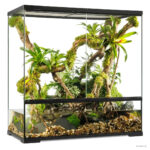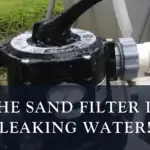Have you recently glanced at your paludarium and noticed tiny white spots marring its once pristine beauty? You’re not alone.
Many paludarium enthusiasts encounter this perplexing issue, and it can be both frustrating and worrying. These mysterious white spots can be more than just an eyesore; they might indicate underlying problems that need your attention. Understanding why they appear and how to tackle them can save you time, money, and a lot of headaches.
Stick around to uncover the reasons behind these spots and discover simple solutions to restore your aquatic paradise to its former glory. With just a bit of knowledge, you’ll be empowered to keep your paludarium healthy and vibrant.
Common Causes Of White Spots
Have you ever glanced at your paludarium and wondered why those pesky white spots have appeared? You’re not alone. These spots can be frustrating, but understanding their common causes can help you address them effectively. Whether it’s mineral deposits or algae growth, each cause has its own solution. Let’s dive into the details.
Mineral Deposits
Mineral deposits are often the culprits behind white spots in paludariums. Hard water, rich in minerals like calcium and magnesium, can lead to buildup. This often occurs on glass surfaces or equipment. You might notice a chalky residue that seems impossible to scrub away.
Consider using distilled water to reduce mineral content. Regular cleaning with vinegar can help dissolve these stubborn spots. Are you seeing streaks after cleaning? That could be another sign of mineral deposits.
Algae Growth
Algae can be another source of white spots. While usually green, certain types may appear white under specific lighting conditions. Algae thrive in environments with excess nutrients and light. Does your paludarium seem brighter than usual? That might be an algae invitation.
Reduce algae growth by controlling light exposure. Introduce algae-eating creatures like snails or shrimp. Maintain a balanced ecosystem to keep algae at bay. Your paludarium will thank you with clearer surfaces.
Fungal Infections
Fungal infections can also manifest as white spots. They often appear on plants or substrates. Have you introduced new plants recently? This might be the source of fungal spores.
Isolate affected plants to prevent spreading. Use antifungal treatments tailored for aquatic environments. Regularly inspect your plants for early signs of infection. Prevention is always better than cure.
Water Quality Issues
Water quality issues can lead to white spots as well. Imbalances in pH or ammonia levels can cause stress in plants and animals. Are you testing your water regularly? It’s crucial to maintain optimal conditions.
Invest in a quality water testing kit. Ensure filtration systems are working efficiently. Adjust water parameters gradually to avoid shock. Consistent monitoring can prevent future issues.
Each of these causes demands attention and action. By identifying the root of the problem, you can take steps to restore your paludarium’s beauty. What steps will you take today to tackle those white spots?

Credit: www.reddit.com
Identifying The Source
White spots in your paludarium can be puzzling. Understanding their origin is key to resolution. Identifying the source involves careful examination of the environment. From water quality to plant health, each aspect plays a role. Let’s dive into these critical areas to pinpoint the source.
Analyzing Water Parameters
Start by testing the water. Check for imbalances in pH and hardness. High mineral content often leads to white residue. Use a reliable test kit to measure levels. Adjust parameters to optimal conditions. Consistent monitoring helps maintain balance. Regularly clean and filter the water to prevent build-up.
Examining Plant Health
Healthy plants are essential. Inspect leaves for spots or discoloration. White patches may indicate fungal infections. Ensure proper lighting and humidity. Trim affected leaves to promote recovery. Use natural remedies to treat plant diseases. Vibrant plants contribute to a healthy ecosystem.
Inspecting Tank Surfaces
Examine the tank walls and decorations. White spots can be mineral deposits. Scrub surfaces gently to remove residue. Check for algae growth on glass. Regular cleaning prevents accumulation. Use safe cleaning agents to avoid damage. Clean surfaces enhance visual appeal and health.
Preventive Measures
White spots in your paludarium can be a real nuisance, often indicating underlying issues that need addressing. Thankfully, preventing these spots is easier than you might think. By focusing on key areas such as maintenance, water chemistry, and ventilation, you can keep your paludarium healthy and spotless. Let’s dive into these preventive measures that can save you time and frustration.
Regular Maintenance Routine
Consistency is your best friend when it comes to maintaining a pristine paludarium. Regular cleaning prevents algae buildup and keeps white spots at bay. Remember the time I skipped a cleaning session, only to find my tank dotted with stubborn spots? Lesson learned! Stick to a schedule—weekly checks and cleaning can make all the difference.
Consider creating a checklist to ensure nothing gets overlooked. Clean glass surfaces, remove debris, and check filters. These small tasks are crucial for a spotless environment.
Balanced Water Chemistry
Water chemistry plays a vital role in preventing white spots. Imbalanced pH levels can lead to deposits that mar your tank’s beauty. Test your water regularly. Have you ever thought about how a slight change in water parameters can affect your ecosystem?
Use water conditioners to stabilize pH and mineral content. This simple step can prevent white mineral spots from forming, keeping your paludarium looking fresh.
Proper Ventilation
Ventilation is often overlooked but is essential for preventing moisture-related issues. Stagnant air can lead to mold and white spots. How does air circulation affect your paludarium’s health?
Ensure your setup has adequate airflow. Use fans or adjust openings to improve circulation. Good ventilation keeps humidity levels in check and prevents unwanted spots.
Implementing these preventive measures can transform your paludarium experience. Don’t let white spots ruin your enjoyment and the beauty of your aquatic environment. Act now and relish in the clarity and health of your paludarium!
Effective Cleaning Techniques
White spots in your paludarium can be frustrating. They often appear on plants, rocks, and glass, disrupting the beauty of your aquatic environment. Fortunately, there are effective cleaning techniques to tackle these spots and restore the pristine look of your paludarium. Let’s dive into some practical methods that you can easily apply.
Using Safe Cleaning Agents
Choosing the right cleaning agents is crucial for the health of your paludarium. You want to ensure that whatever you use is safe for both your plants and aquatic life. Opt for natural solutions like vinegar mixed with water. It’s a gentle yet effective way to clean surfaces without harming the ecosystem.
Commercial aquarium-safe cleaners are another option. These are specifically formulated to tackle tough spots without introducing harmful chemicals. Always read the labels and follow the instructions to maintain a safe environment for your plants and creatures.
Manual Scrubbing Methods
Sometimes, elbow grease is your best friend. Use a soft-bristled brush to gently scrub away white spots. Make sure the brush is non-abrasive to avoid scratching delicate surfaces.
Microfiber cloths can also work wonders on glass and larger surfaces. They’re great for reaching tight corners where spots often hide. Regular scrubbing as part of your maintenance routine can prevent the buildup of these pesky spots.
Utilizing Algae Eaters
Have you ever considered letting nature do the cleaning for you? Algae eaters, like certain fish or snails, can be an excellent addition to your paludarium. They naturally consume algae and can help keep white spots at bay.
Research the best species that fit with your existing flora and fauna. Not all algae eaters are suitable for every setup, so it’s important to find a compatible match. Adding these creatures can add an interesting dynamic to your ecosystem while keeping it clean.
Have you tried these methods before? Which worked best for you? Keeping your paludarium spotless not only enhances its visual appeal but also promotes a healthier environment for your plants and animals. Implement these techniques and watch your aquatic space thrive!
Natural Remedies
White spots in a paludarium often indicate hard water deposits or algae growth. Identifying the cause is crucial for effective treatment. Natural remedies include adjusting water parameters or introducing algae-eating organisms to maintain a healthy ecosystem.
White spots in your paludarium can be quite the nuisance, especially when you’re aiming for a vibrant, healthy ecosystem. But fear not, there are natural remedies that can help you tackle these pesky spots effectively. These solutions not only enhance the beauty of your setup but also promote a balanced environment for your aquatic and terrestrial inhabitants. Let’s dive into some practical tips.Introducing Beneficial Bacteria
Beneficial bacteria can be your best ally in maintaining a healthy paludarium. These tiny helpers break down waste and organic matter, preventing algae and other unwanted growths. Adding bacterial supplements designed for aquariums can boost the natural cleaning process. They work wonders in maintaining water clarity and reducing white spots. Regularly monitoring water quality can help you gauge the effectiveness of these bacteria. Have you noticed a decline in white spots after introducing them?Incorporating Natural Deterrents
Sometimes, nature offers the best solutions. Consider adding certain plants known for their ability to deter algae and mold. Floating plants like duckweed can shade the water, reducing algae growth. Their roots also absorb excess nutrients, starving the white spots of their food source. You might also try adding snails or shrimp that feed on algae. These critters not only clean your paludarium but add a dynamic touch to your ecosystem. Have you ever thought about using natural remedies for other issues in your setup? It might be worth exploring the benefits they bring beyond just tackling white spots. By embracing these natural solutions, you can enjoy a thriving, spot-free paludarium while promoting a sustainable environment for all your creatures.
Credit: www.reddit.com
When To Seek Professional Help
White spots in your paludarium can be concerning, and knowing when to seek professional help is crucial. While some issues can be managed with DIY solutions, others may require the expertise of a professional. Understanding the signs that indicate a need for professional intervention can save your plants and creatures from further harm. Let’s explore when it’s time to call in the experts.
Persistent Problems
If you’ve tried various methods to eliminate the white spots and nothing seems to work, it might be time to seek professional help. Persistent issues often indicate underlying problems that are not immediately visible. A professional can diagnose these hidden issues and provide solutions that you might not have considered.
For instance, when my paludarium had recurring white spots despite regular cleaning, I discovered it was due to an imbalance in the tank’s ecosystem. A professional’s insight helped me restore balance, preventing further damage.
Severe Plant Damage
Severe damage to plants is a clear sign that you need expert intervention. When leaves are turning brown or falling off in large numbers, the problem could be more than just cosmetic. Professional help ensures a thorough assessment, addressing not just the symptoms but the root cause.
Have you noticed your plants losing vitality rapidly? This could indicate a significant issue that needs immediate attention. A professional can offer a tailored solution to revive your plants and maintain a healthy environment.
Comprehensive Water Testing
Water quality is a crucial factor in maintaining a healthy paludarium. If you’re unable to pinpoint the cause of white spots, comprehensive water testing by a professional can reveal imbalances or contaminants. This step is essential if basic water tests don’t provide clear answers.
In my experience, professional water testing unveiled high levels of minerals that were affecting the ecosystem. Addressing the water quality improved the overall health of the paludarium significantly.
Have you ever considered the impact of unseen elements in your water? A professional can provide detailed insights and corrective measures that elevate the quality of your habitat.
By recognizing these signs and knowing when to seek professional help, you can ensure the long-term health and beauty of your paludarium. Have you faced similar challenges? Share your experiences and let’s learn from each other.

Credit: www.facebook.com
Frequently Asked Questions
What Causes White Spots In Paludariums?
White spots often result from mineral deposits. Hard water can leave calcium or lime residues on surfaces.
How Can I Prevent White Spots?
Regular cleaning helps prevent buildup. Use distilled water to minimize mineral deposits in your paludarium.
Are White Spots Harmful To Plants?
White spots are usually not harmful. They mainly affect appearance. Regular maintenance keeps plants healthy.
Can White Spots Affect Fish Or Amphibians?
White spots typically don’t impact fish or amphibians. Check water quality to ensure their safety and comfort.
How Do I Clean White Spots Effectively?
Vinegar solution works well. Gently scrub surfaces to remove spots. Rinse thoroughly to avoid vinegar residue.
Conclusion
White spots in your paludarium can be frustrating. They might signal issues. Regular checks help catch problems early. Clean and maintain your setup often. Adjust lighting and water conditions. This reduces unwanted growth. Always choose quality materials for your paludarium.
They prevent common issues. Research before adding new elements. This ensures compatibility. Understand the needs of your plants and animals. Proper care leads to a thriving paludarium. Stay patient and observant. Your efforts will show. A balanced environment keeps white spots away.
Enjoy a healthy and vibrant paludarium space.




